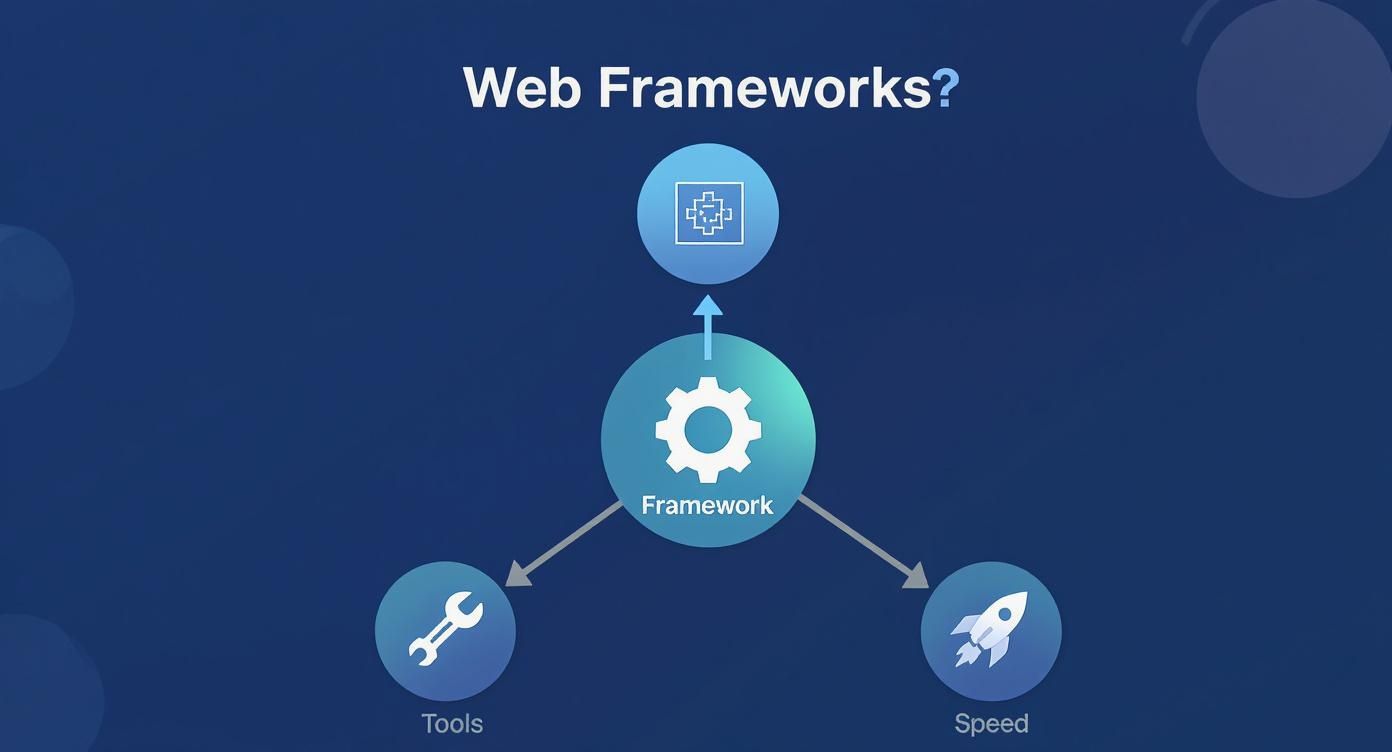what is a web application framework? A quick intro
what is a web application framework? Explore how these tools simplify structure, speed up development, and let you build scalable apps with confidence.

Think of a web application framework as a professional-grade toolkit for building websites and apps. It's not just a collection of tools; it's a structured blueprint that guides you, saving you from having to build every single piece of your project from the ground up.
This structure makes development faster, more organized, and far less prone to common mistakes.
Building Web Apps The Smart Way
Let's use an analogy. Imagine you want to build a house. You could, in theory, go out and chop down the trees, mill the lumber, and forge every nail yourself. You'd have ultimate control, but it would be an incredibly slow, difficult, and error-prone process.
A web framework is like starting with a professionally engineered foundation, frame, and roof already in place. Instead of spending your time on basic plumbing and electrical wiring, you can focus on what makes the house a home—the layout, the design, and the unique features your client wants.
That’s exactly what frameworks do for developers. They handle the tedious, repetitive tasks like user authentication, database connections, and security protocols, freeing up developers to focus their creativity on the unique business logic and user experience that truly matter.
Why Not Start From Scratch?
The main problem frameworks solve is the need to constantly "reinvent the wheel." Modern web applications share a lot of common components, and building them all from scratch for every single project is a huge waste of time and resources.
Without a framework, developers often run into the same old problems:
- Snail's Pace Development: Manually coding every function takes a massive amount of time.
- More Bugs: Custom-built solutions for standard problems are more likely to have hidden flaws.
- Security Gaps: It's incredibly difficult for one person or a small team to anticipate and guard against every possible security threat.
Frameworks provide a battle-tested and secure foundation that has been refined by thousands of developers. Their widespread use is a testament to their value. For example, ASP.NET is a powerhouse, used by over 591,000 websites and holding a 37% market share. Meanwhile, a newer favorite, Next.js, already runs on nearly 390,000 sites. You can dig into more stats like these over at Wappalyzer's framework usage data.
To really see the difference, let’s compare the two approaches side-by-side.
Building a Web App From Scratch vs With a Framework
| Development Task | Building From Scratch | Using a Framework |
|---|---|---|
| User Authentication | Write custom code for logins, signups, password resets. | Use a pre-built authentication module. |
| Database Connection | Manually write and manage database drivers and queries. | Use a built-in ORM (Object-Relational Mapper) to simplify data handling. |
| URL Routing | Create your own system to handle URL requests. | Define simple rules in a routing file. |
| Security | Research and implement defenses for SQL injection, XSS, etc. | Get built-in protection against common vulnerabilities. |
| Code Structure | Design your own file and folder organization. | Follow a standardized and proven architecture. |
| Testing | Set up a testing environment and write all test cases. | Leverage integrated testing tools and structures. |
As you can see, using a framework offloads a huge amount of foundational work, letting developers get straight to the creative and valuable parts of the project.
By providing a structured environment, web application frameworks enforce best practices, improve code maintainability, and drastically cut down the time it takes to get an application from an idea to a live product.
How a Web Framework Actually Works
Think of a web framework like the chassis and engine of a car. You don't have to build these complex, foundational parts from scratch every time you want a new vehicle. Instead, you start with a proven, reliable structure and build on top of it.
This pre-built structure handles all the heavy lifting behind the scenes. It's a whole system of components working together to turn a user's request—like clicking a link—into a fully loaded webpage, and it does it fast.
At the very heart of this system is something called URL routing. This is the website’s traffic cop. It reads the URL in the browser (like /blog/my-first-post) and directs that request to the exact piece of code that knows how to handle it. Without routing, your application would be a chaotic mess of dead ends.
Once the router points the way, other key parts of the framework kick in.
This visual map helps show how a framework provides the structure, tools, and speed needed for modern web development.

As you can see, a framework isn't just one tool. It’s an integrated ecosystem that gives developers a blueprint and all the necessary parts to build applications much faster.
Key Internal Components
So what’s actually inside the box? A good framework bundles several solutions to common development headaches. Many are designed around the Model-View-Controller (MVC) pattern, a popular way to organize code.
The MVC approach splits the application into three distinct, interconnected jobs:
- Model: This is the brain of the operation. It manages the application's data and business rules, talking directly to the database to fetch things like user profiles or product inventory.
- View: This is what the user actually sees and interacts with—the user interface (UI). It takes the data from the Model and presents it as a webpage.
- Controller: The controller is the middleman. It takes input from the user (via the View), processes it, and then tells the Model and the View what to do next.
Keeping these roles separate makes the code incredibly clean, organized, and much easier to update down the road.
Another game-changing component is the Object-Relational Mapper (ORM). An ORM is a clever bit of programming that acts as a translator between your application's code (like Python or JavaScript) and a database (like PostgreSQL).
Instead of writing tedious and complex SQL queries by hand, developers can work with the database using the programming language they already know. This massively simplifies data handling and cuts down on common errors.
For a closer look at how these pieces fit together in a real-world scenario, check out our guide on Python web application development. By bundling these powerful components, frameworks provide a solid, scalable foundation for any project.
Why Top Developers Rely On Frameworks
Imagine building a skyscraper brick by brick. Now picture arriving on site with pre-fabricated steel beams, pre-cut windows, and a full crew ready to assemble them. That’s exactly what a web framework gives your team: a shortcut through repetitive work so you can focus on crafting the real value.
The three biggest payoffs are speed, security, and stability.
- Speed: Frameworks bundle common features—user authentication, database connections, routing—so you skip the boilerplate and jump straight into your app’s special sauce.
- Security: Out-of-the-box protections guard against SQL injection, cross-site scripting (XSS), and other attacks.
- Stability: With active maintenance and regular updates, the framework evolves alongside best practices, keeping your project solid over time.
That rush of efficiency isn’t just talk. The global web framework market is on track to hit $212.8 billion by 2029, growing at an impressive 19.1% annually. You can dive deeper into the numbers in this detailed market research report.
Built-In Security And A Global Support System
You don’t need to become a cybersecurity guru overnight. Frameworks ship with:
- Hardened defenses against SQL injection
- Automatic safeguards for cross-site scripting (XSS)
- Regular security patches from a core team of experts
When you choose a framework, you’re drawing on the collective wisdom of thousands of developers who’ve already solved the same problems you’re facing.
And if you ever hit a snag? A global community is ready to jump in. From active forums and plugins to thorough documentation, this ecosystem keeps projects moving forward and sparks fresh ideas. It’s this blend of rapid development, built-in security, and community support that makes frameworks the go-to choice for professional teams.
Popular Web Frameworks and Who Uses Them
Ever wonder what’s running under the hood of your favorite websites? Chances are, it’s a web application framework. The biggest names on the web didn't build their platforms from scratch; they stood on the shoulders of these powerful tools, picking the one that best matched their vision.

These frameworks are the engines powering products we use every day. By looking at which companies use which framework, we can get a real sense of their strengths and see how a team's choice of tools directly shapes the final product you experience.
Django: The Python Powerhouse
Built with Python, Django is famous for its "batteries-included" approach. Think of it like a fully-stocked kitchen—it comes with everything you need right out of the box, from an admin panel to tools for talking to your database. This lets developers build complex, data-heavy apps incredibly fast.
It’s the perfect choice for projects that need to move quickly without cutting corners on security or the ability to grow.
- Who uses it? Instagram, Pinterest, and Spotify all trust Django to manage their huge amounts of data and millions of users. Its organized structure is a natural fit for content-rich sites and social networks.
Next.js: For The Modern Web
In the JavaScript world, Next.js has become the go-to for building slick, high-performance web apps. It's built on top of React and is brilliant at creating websites that are both lightning-fast and easy for search engines to find.
Next.js takes tricky but essential tasks, like server-side rendering (SSR), and makes them simple.
Its focus on a great developer experience and built-in performance boosts has made it a favorite for companies where speed is everything.
- Who uses it? Giants like Netflix and TikTok use Next.js to deliver their smooth, responsive interfaces to a global audience. It's a top choice for e-commerce stores, marketing websites, and any app where performance directly impacts the bottom line.
To give you a clearer picture, here’s a quick comparison of some of the heavy hitters in the framework world.
Comparing Popular Web Frameworks
This table compares key features of leading web frameworks to help you understand their differences and primary use cases.
| Framework | Language | Best For | Example Company |
|---|---|---|---|
| Django | Python | Complex, data-driven applications and rapid development | |
| Next.js | JavaScript (React) | High-performance, SEO-friendly marketing and e-commerce sites | Netflix |
| Ruby on Rails | Ruby | Startups and projects needing fast prototyping and development | GitHub |
| Laravel | PHP | Full-featured applications with a focus on elegant code | 9GAG |
As you can see, the choice of framework often comes down to the programming language the team knows and the specific problem they're trying to solve.
Exploring the best web application frameworks will show you the full spectrum of what’s out there. Each one offers a different philosophy for tackling the challenges of web development, from Python’s structured reliability to JavaScript’s dynamic flair.
How to Choose the Right Framework for Your Project

Pick your framework carefully—it’s the foundation for every line of code that follows. It’s not about a universal champion but what clicks with your needs now and down the road.
Start with some honest questions. The clearer your answers, the sharper your direction.
Key Factors To Consider
Now, break down your decision into three core areas:
-
Team Expertise: What do your developers already know? If Python is their comfort zone, then Django might let you hit the ground running. Leveraging existing skills speeds things up.
-
Project Complexity: Will this be a simple landing page or a feature-packed SaaS platform? Lightweight frameworks shine on small builds, while full-stack solutions handle heavy lifting without extra glue.
-
Scalability Needs: Think long term. Are you preparing for a few hundred users or millions? Some tools are built to grow smoothly under high traffic.
The goal is to pick a framework that meets today’s demands and won’t turn into a bottleneck as your app scales. A smart choice here pays off later.
Beyond traditional frameworks, some projects might benefit from exploring the best low-code development platforms available. Additionally, comparing popular choices like Django vs. Rails can provide valuable insights; our article offers a deep dive into choosing between Django and Rails.
The Future of Web Application Frameworks
Web development never stands still, and the frameworks we rely on are changing just as quickly. The future isn't just about speed; it’s about building smarter, more intuitive applications with less hassle.
We're already seeing a few major trends take hold. One of the biggest is the deeper integration of AI and automation. Imagine frameworks that don't just provide a structure, but actively help you code by handling repetitive tasks or suggesting better ways to write a function. This frees up developers to tackle the creative, complex problems that really matter.
At the same time, there's a huge push toward serverless architectures. Frameworks are adapting to help us build powerful applications without ever having to think about managing the servers they run on.
The most visible trend, however, is the focus on Progressive Web Apps (PWAs). These are all about delivering a smooth, native app-like experience right inside a web browser—no app store required.
This relentless focus on better user experiences is a massive driver of growth in the web development market, which is expected to hit $104.31 billion by 2030. A huge chunk of that growth comes from the PWA segment, proving just how important this technology has become.
If you're curious about the numbers, you can dig into more web development statistics and their impact. It’s clear that keeping up with these frameworks isn't just about the web of today—it's about getting ready for what's coming next.
Answering Your Top Questions About Web Frameworks
As we wrap up, let's tackle a couple of questions that almost always pop up when people are first getting their heads around web frameworks.
Is a Framework the Same Thing as a Library?
That's a great question, and the short answer is no. They might seem similar, but the core difference comes down to who’s in charge.
Think of a library like a hardware store. You go in, grab the specific tools you need (like jQuery for tweaking something on a webpage), and you use them when and how you see fit. You’re in control.
A framework, on the other hand, is like building a house from a prefabricated kit. It provides the foundation, the walls, and the overall structure. Your job is to fill in the details and customize the rooms. The framework calls on your code, not the other way around. This concept is often called "Inversion of Control," and it's what gives frameworks their power and structure.
So, Do I Really Need to Use a Framework?
Technically, no. You could absolutely build a web app from the ground up, writing every single line of code yourself.
But for anything more complex than a basic, one-page website, you'll almost certainly want one. Trying to build a modern web app from scratch is like trying to build a car from raw metal—it’s possible, but incredibly difficult and time-consuming. Frameworks give you security features, a solid structure, and pre-built components that save you a massive amount of time and prevent countless headaches.
Ready to build a high-performance web application without the guesswork? 42 Coffee Cups specializes in Next.js and Django development, helping you launch faster and scale smarter. Get in touch with our experts today!